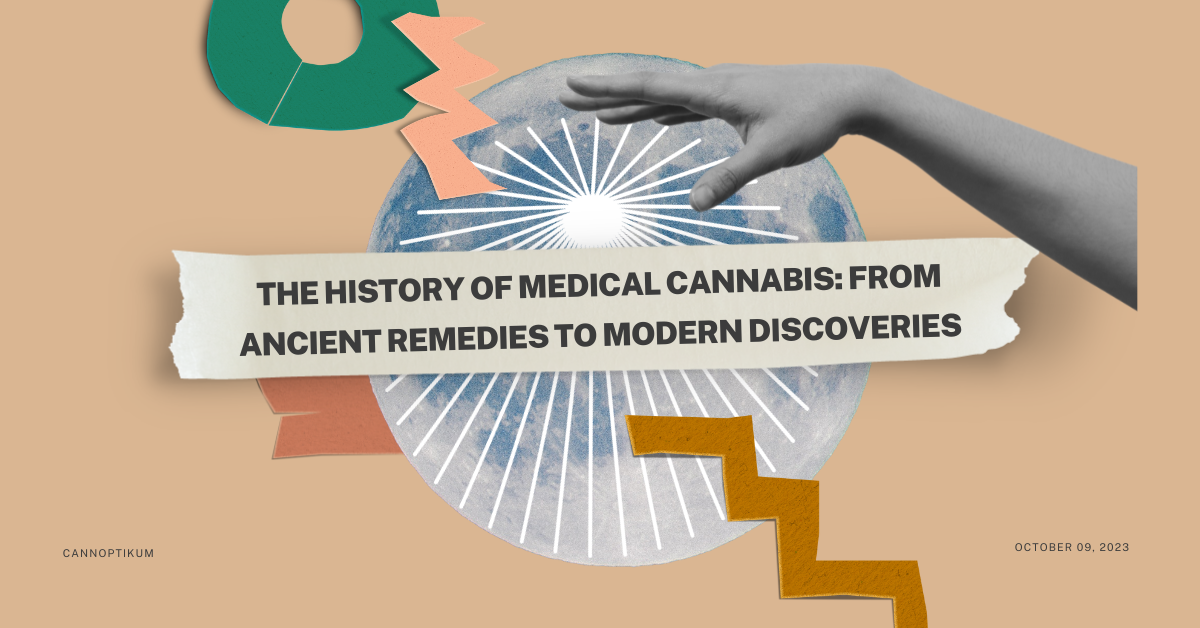Read time: 6-7 minutes
Table of Contents
- Historical Origin of Cannabis in Medicine
- Spread and Uses in Various Cultures
- Best Medical Cannabis Strains
- Heyday and Decline in the Ancient World
- Middle Ages and Early Modern Period
- Prohibition and Modern Rediscovery
- Current State of Medical Application of Cannabis
- Conclusion
The use of cannabis for medical purposes has a fascinating and long history dating back to ancient China. As far back as 2700 BCE, cannabis was discovered as a remedy in China. The first written document about the medical use of cannabis dates from this time and is attributed to the mythical Emperor Shen-Nung, one of the founders of Chinese medicine. From China, the plant spread to India around 800 BCE and was used as a remedy during Vedic times. Even in the sacred scriptures of the Persians, the Avesta, the narcotic effect of hemp in Persia is mentioned.
Spread and Uses in Various Cultures
In ancient Egypt, cannabis became known around 1500 BCE and was even mentioned in older papyri. The Scythians, an Indo-European equestrian people, used hemp in steam baths to experience its intense effects. In Assyria, in the border region between Iran and Iraq today, cannabis preparations were used for various ailments, both externally and internally. The use of hemp as medicine was also known in ancient Greece and Rome, although its use as a narcotic was uncertain during this time. Although the psychoactive effect was known, cannabis was hardly used as a narcotic. Nevertheless, there are indications in antiquity of the use of cannabis in various cultures. In ancient India, Persia, Egypt, and even among the Scythians, hemp was used medicinally, often with anesthetic intent.
Best Medical Cannabis Strains
Here is a list of some of the best medical cannabis strains used for various health conditions:
Super Lemon Haze not only has a great taste, but also many medicinal benefits. Find out more about the positive effects of Super Lemon Haze in our blog post.
- OG Kush: This strain is often used for pain relief and insomnia.
- CBD Charlottes Angel: Particularly known for treating epilepsy in children.
- CBD Terra Italia: This strain has a low THC and high CBD ratio and is used for anxiety and inflammation.
- Harlequin CBD: A strain with a balanced THC to CBD ratio, ideal for pain relief without strong psychoactive effects.
- Girl Scout Cookies: This strain is often used for the treatment of nausea and loss of appetite.
Heyday and Decline in the Ancient World
In the Arab-Islamic world, the use of hashish as medicine and a narcotic peaked in the 10th century. Great works of antiquity were translated into Arabic, and medical knowledge was expanded through its cultural influences and others. Hashish was considered both medicine and a narcotic during this time. In the early Middle Ages in Europe, hemp was valued as a remedy by physicians such as the German Abbess Hildegard von Bingen. Hemp seeds were considered healthy food and used for various ailments. Hemp was also mentioned in many herbals and pharmacopoeias of this time.
Middle Ages and Early Modern Period
In the 19th century, cannabis experienced a renaissance in medical application in Europe and the USA. There were increased studies published about the medical properties of cannabis. Indian hemp, promising new therapeutic approaches, found its application in Western medicine. Physicians like William B. O’Shaughnessy successfully used cannabis preparations for various ailments such as rheumatism, cholera, and spasms. In the USA, cannabis preparations were used for medical purposes, especially in cases of tetanus. By the end of the 19th century, cannabis preparations were widely used in Western mainstream medicine. They were used for pain, whooping cough, asthma, and as a sedative. There were also some critical voices, but overall, cannabis preparations were considered valuable medicines. Extensive studies on cannabis were conducted during this time, such as the "Indian Hemp Report" of 1894 in India.
Prohibition and Modern Rediscovery
From the mid-20th century, cannabis preparations disappeared from medicine. New specific drugs were introduced, and the pharmaceutical instability of cannabis preparations and production limitations led to their decline. The Single Convention on Narcotic Drugs of 1961 led to a global ban on cannabis, including its medical use. This resulted in decades of stagnation in medical cannabis research.
Current State of Medical Cannabis Use
In recent decades, cannabis has experienced a remarkable revival in medical research and application. The discovery of the endocannabinoid system in the 1990s led to intensive research on cannabinoids and their medical applications. This discovery was groundbreaking and helped to better understand the diverse effects of cannabis on the human body. Today, cannabis is legally used for medical purposes in some countries, especially for the treatment of epilepsy and other serious diseases. In some countries, THC-containing hemp flowers are also approved for medical purposes. Patients with chronic pain, multiple sclerosis, nausea due to chemotherapy, and other serious diseases find relief in the medical use of cannabis and its derivatives.
Countries Where Medical Cannabis Is Legal
The history of the medical use of cannabis is marked by centuries of use, discovery, forgetfulness, and rediscovery. From ancient civilizations to modern medicine, cannabis has had a long and complex journey. The increasing acceptance and legalization in many countries highlight the changing perception of this plant and its medical potentials. While there are still controversies and challenges, ongoing research suggests that the medical use of cannabis could reveal many secrets for human health, remaining a fascinating and promising area of medical research.
Disclaimer
This website's content is for informational use only and should not be considered medical or legal advice. Always consult a healthcare professional for health-related issues. Be aware of local regulations regarding cannabis cultivation. We are not liable for any actions taken based on this information.

